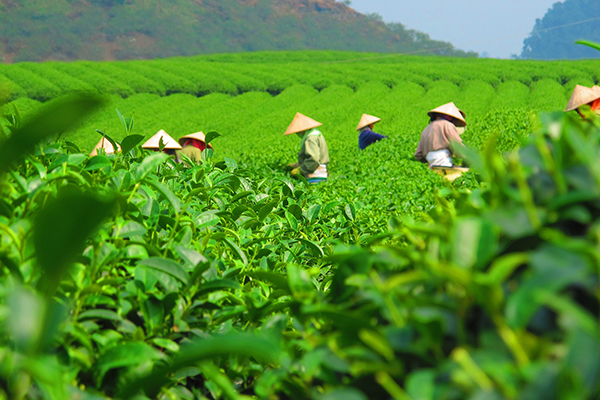
Coffee and tea are the most popular drinks around the world, and of course we all love chocolate. However, special attention should be paid to these crops not only because of their environmental impact but also because of the social injustice issues that are pervasive among these industries.
All three industries are extremely lucrative, with sales and profits in the 100’s of billions per year. The other thing all three industries have in common is that the majority of the sales and consumption are in industrialized nations while they are cultivated, harvested and exported by the world’s poorest nations.
Enjoy your morning coffee or tea without the worry of social injustice issues. #FairTrade #ecofriendly #saslife Click To TweetWhen we are enjoying our morning coffee or tea or that sweet chocolate treat, we’re not usually thinking of slave labor, sexual abuse or child labor. But unfortunately, that is the reality in these industries. The anti-slavery organization Walk Free Foundation estimated in a 2018 report that there are 890,000 children working in the cocoa sector. Human rights violations have been reported at plantations in virtually all major tea producing countries. And the coffee industry has similar issues.
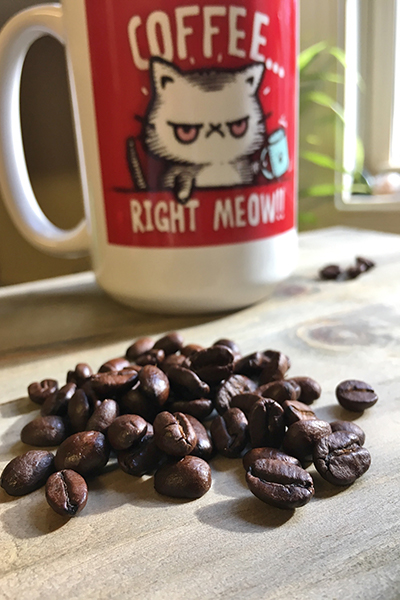
The environmental impact of these industries focuses mainly around heavy pesticide and herbicide use as well as deforestation, which lead to reduced biodiversity, increased soil erosion and other issues we tend to associate with monocropping practices commonly seen with soy, wheat and corn crops.
So, what can we do?
Luckily there are a growing number of companies that ARE doing the right thing. There are certifications to look for to help us figure this out.
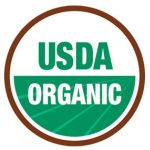
Organic is the first to look for because all three crops can be heavily sprayed with pesticides.
 Fair Trade Certified guarantees that there is sustainable production and fair prices for small farmers, safe working conditions, no forced child labor. It also address the use of pesticides, and supports credit plans and training for farm workers.
Fair Trade Certified guarantees that there is sustainable production and fair prices for small farmers, safe working conditions, no forced child labor. It also address the use of pesticides, and supports credit plans and training for farm workers.
 Fair for Life guarantees that farmers receive fair payment and that workers have good and fair working conditions. The Fair for Life system prevents forced child labor and also includes detailed environmental criteria.
Fair for Life guarantees that farmers receive fair payment and that workers have good and fair working conditions. The Fair for Life system prevents forced child labor and also includes detailed environmental criteria.

Rainforest Alliance Certified means that chemical pesticide use was limited, water and soil were conserved, and workers were treated fairly.
You might also see, Bird Friendly or Shade Grown certifications that address environmental impact.
A few brands that are doing it right
There are more and more brands that are trying to do the right thing although they still make up a small percentage of the overall market. This is not an exhaustive list.
Coffee - Larry’s Coffee, Counter Culture and Equal Exchange (coffee, chocolate and tea)
Tea - Numi, Yogi Teas, Choice Organic Teas and Rishi
Chocolate - Equal Exchange, Endangered Species, Theo, and Alter Eco
None of these are perfect and may not be a 100% guarantee that everything is fair and just for the people growing these crops, but that shouldn’t stop you from trying.
Check out Healthy & Environmentally Friendly Food Choices for more information on how your food choices impact our planet.
Figgy Chocolate Truffles
Servings: Makes about 24 truffles
Recipe adapted from: AmyMyersMD.com
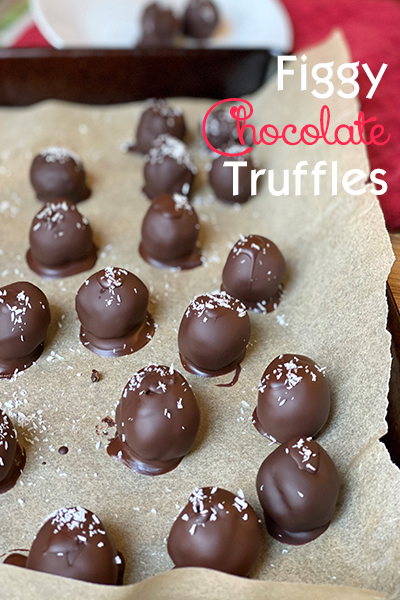
Ingredients
Chocolate Truffles
1 ½ cup dried figs
6 Tbsp unsweetened cocoa powder
¼ cup coconut cream
Chocolate Coating
3 oz dark chocolate (I used 85% cocoa)
1 Tbsp coconut oil
Optional Toppings
unsweetened cocoa powder
shaved chocolate
shredded coconut
flaked sea salt
Instructions
- Remove the stems from the figs, and place them in a food processor, along with cocoa powder and coconut cream. Process until the mixture is completely smooth and has formed a ball. Remove from the food processor with a spatula, and place into a medium bowl. Store in the refrigerator for 5 minutes.
- Remove truffle dough from the refrigerator. Scoop rounded teaspoons of the truffle mixture onto a sheet of parchment paper. Do not roll into balls yet. Tip: keep a small bowl of warm water next to you, and dip your fingers in the water to remove truffle mixture from your fingers. This process can be messy and the water helps keep things moving.
- Carefully slide the parchment paper onto a plate or baking sheet, and place in the freezer for about 5 minutes. Remove from the freezer and roll into truffle balls. When all the truffles have been formed into spheres, place them back in the freezer while you prepare the coating.
Chocolate Coating
- In a small saucepan, combine chocolate and coconut oil. Melt slowly over low heat, stirring continuously until smooth and well-combined.
- Remove truffles from the freezer. Using toothpicks, skewers, or a fork, pierce 1 truffle at a time and dip the truffle into the chocolate coating mixture. Twirl the toothpick around to completely coat the truffle. Carefully slide the truffle off the toothpick onto a piece of parchment paper or wire cooling rack.
- Before the chocolate coating dries, sprinkle with optional toppings such as shredded coconut, chocolate shavings, or flaked sea salt.
- Allow the chocolate coating to cool and solidify completely before serving.
Store truffles in the refrigerator or freezer.
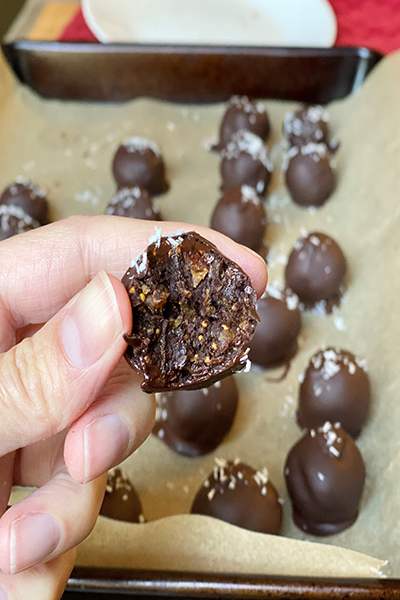

2 Comments
Great article, thanks for the information, clarification and brand reference
You're welcome, I'm glad it was helpful!